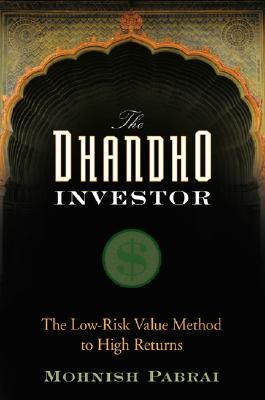

Washington Bullets is a book infused with this madness, the madness that dares to invent the future. It took the madmen of yesterday for us to be able to act with extreme clarity today. In this case, it comes from nonconformity, the courage to turn your back on the old formulas, the courage to invent the future. One such is Thomas Sankara of Burkina Faso - also assassinated - who said: "You cannot carry out fundamental change without a certain amount of madness. It is a book that could easily have been a song of despair - a lament of lost causes it is, after all, a roll call of butchers and assassins of plots against people's movements and governments of the assassinations of socialists, Marxists, communists all over the Third World by the country where liberty is a statue.ĭespite all this, Washington Bullets is a book about possibilities, about hope, about genuine heroes.
THE DHANDHO INVESTOR AUDIBLE FULL
It is a book of fluent stories, full of detail about US imperialism, but never letting the minutiae obscure the larger political point. If you have any interest in the brain, it is well worth the time.Washington Bullets is written in the best traditions of Marxist journalism and history-writing. I finished weeks ago and I'm still talking about pseudocyesis and its link to social norms, among other interesting facts that I learned from this book. I have nothing negative to say about his performance. We also offer a stock picking service using our own value investing system.

It is a step-by-step guide to setting up an account, buying your first stock and navigating the market. Neil Shah does an excellent job on this one. Start Investing is here to help people who are new to investing. And after doing so, he distills it all down to plain language, communicating his ideas effortlessly. He draws beautiful, wide connections across the brain and simultaneously across theories of the brain. Once you hear it, you can't believe that we ever thought anything different. Ramachandran's work in neuroscience is stunning. When I saw his name attached to this book, I purchased it without hesitation. In the flood of scientists and peer review, his work stood out enough that even years later I was still talking about some of his theories. Ramachandran's work during my undergraduate degree. Unique Neuroscience from a Unique Neuroscientist I highly recommend this book if brain biology, physiology, disorders, and functioning are of interest to you. Often he performs simple accompanying experiments which usually provide support for his theories.

Much of the presented information is based not only on the brain's physiology but also the author's theories. Just the fact that he is not afraid to explore these ideas makes this book even more interesting for me. Ramachandran is a brilliant neuroscientist who has a very inquisitive and curious mind which leads him to ask questions that other scientists avoid such as the role of the brain in religion or multiple personality disorder. He describes cases of patients who are in denial of a paralyzed limb, those who have lost awareness of the left side of their bodies, those who are savants, those who have religious experiences during epileptic episodes along with many other interesting and some times controversial topics. He discusses the roles of the different sides of the brain and how injuries or defects in various structures can affect the patient in really diverse and odd ways. Ramachandran addresses various neurological disorders and oddities with his own insights into how these problems might arise. Ramachandran's inspired medical detective work pushes the boundaries of medicine's last great frontier-the human mind-yielding new and provocative insights into the "big questions" about consciousness and the self. A man who insists he is talking with God challenges us to ask: Could we be "wired" for religious experience? A woman who hallucinates cartoon characters illustrates how, in a sense, we are all hallucinating, all the time.ĭr. Some of his most notable cases: A woman paralyzed on the left side of her body who believes she is lifting a tray of drinks with both hands offers a unique opportunity to test Freud's theory of denial. Ramachandran recounts how his work with patients who have bizarre neurological disorders has shed new light on the deep architecture of the brain, and what these findings tell us about who we are, how we construct our body image, why we laugh or become depressed, why we may believe in God, and how we make decisions, deceive ourselves, and dream. His bold insights about the brain are matched only by the stunning simplicity of his experiments - using such low-tech tools such as cotton swabs, glasses of water, and dime-store mirrors. Ramachandran is internationally renowned for uncovering answers to the deep and quirky questions of human nature that few scientists have dared to address.


 0 kommentar(er)
0 kommentar(er)
